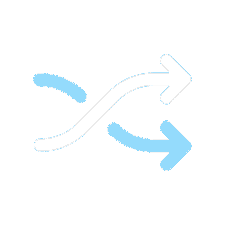- Research platform
Sources of information
Data analysis
Actions
- Solutions
For whom
Problems / Issues
- Materials
Materials
- About us
About us
The stage of designing research questionnaires and formulating questions is one of the most important in the process of creating an effective CX strategy - the ability to ask questions is very important here. Not only does the usability of the data and the reliability of the analyses conducted afterwards depend on the quality of the questions, but also the broader UX. In this article, we will present some principles to follow when creating surveys and when asking questions.

After identifying the areas to be surveyed (you can read more about it here), it is necessary to characterize the target group accurately. In doing so, it is important to determine both the context in which the user will be placed and the emotions that accompany the activity. A different type of target audience will be someone evaluating a two-week stay in the tropics, and another will be someone using an internal search engine at an online store offering electronics, for example.
This question should be asked first and foremost in the context of identifying the overall goals you are pursuing in designing a particular questionnaire. If a specific question has a rationale, don't be afraid to apply it - after all, there are no stupid questions. As an example, let's take a survey after contacting a consultant via livechat, which can be used to increase the quality of the service provided, identify technical errors and collect individual consultant evaluations to be used later in organizing training and awarding bonuses.
It will be important to think about how individual questions will contribute to these goals, which will be helped by a detailed breakdown of the purpose of each question. It will help avoiding wrong questions and thus receiving wrong information.

The next step will be to assign a question type to each issue raised. Examples of question types used in YourCX surveys are:
Single-choice (radiobutton) questions
Multiple-choice (checkbox) questions
Open-ended or semi-open-ended questions (the latter are used to streamline the process of analyzing open-ended responses and involve including an open-ended box with one of two choices, e.g. "Is there anything we can improve?" with the options "No" and "Yes, enter your suggestion:"). It's a good example of follow up questions.
NPS questions (rating the likelihood of recommending a service, service or brand on a scale of 0 to 10)
Continuous scale questions (rating selected with a "slider")
Single- or multiple-choice matrix questions (so-called "tables" in which it is possible to evaluate different issues)
Ranking questions
Click map question or heatmap question.
Don't be afraid to use open-ended questions. Appropriate open-ended questions allow you to get answers quickly in ad-hoc surveys, for example. Open questions also show that you're a good listener and you're paying attention to real feelings and thoughts. Automatic text processing allows you to understand the respondent's statements almost in real time, to find out what people are thinking, so the best way to quickly get answers or dredge is to use appropriate open-ended questions.

The right questions are not enough. Asking such questions involves their proper layout and logic to keep proper peace and "conversation flow". Avoid questions whose answer is limited to "yes" or "no," and choose scalable questions as often as possible. There is a difference between a "very helpful" and a "helpful enough" consultant. Also, remember to base the entire questionnaire on similar scale logic, that is, if in the first question the negative answer is on the left and the positive answer is on the right, then subsequent questions should be based on the same premise.
Open-ended questions are worth using as in-depths (i.e., supplementary questions) for assigned grades, in order to better understand the reasons for choosing answers in closed questions. Also, you need to pay attention to what the first question in the survey is. If it is too difficult, not in the right context relative to the previous invitation, it will reject the respondent. As the first question, it is good to ask a closed question and later follow up questions.
In addition to issues related to the initial definition of objectives at the first stage, it is important to consider later ways of analyzing the data collected. When you ask a question, an idea of how you want to use the answers right away. Extremely important in this context is segmentation, i.e. the juxtaposition of different types of questions in order to verify hypotheses or assess the importance of a given issue for the overall health of the site or brand.
For example, segmenting the goals of a visit according to the NPS index or navigation rating will identify those goals that users have the most trouble completing. In this context, you can also think about using so-called "dual importance mapping," which we will write about in more detail in another article.
In online communication it is accepted to address each other "per you", hence there is nothing wrong with using the direct form in surveys. However, when doing so, be sure to include both the masculine and feminine forms. For slightly more specific audiences, such as business customers or consumers of luxury goods, it is suggested to use the "Mr./Ms." form. Try to keep right tone in all survey questions.
When creating surveys, follow the KISS principle - Keep It Short and Simple, which simply means "the shorter, the better" and with simple language avoiding complicated jargon. Also, don't expect respondents to spend more than 10 minutes completing the survey. A questionnaire that is too long and questions that are too complicated cause respondents to lose focus and understanding of subject, give up on completing or even get frustrated, which is unacceptable for surveys aimed at improving satisfaction. So remember to avoid understatement and minimize as much as possible the share of responses based on misunderstanding of the question.
The following points about asking questions are important here:
Clarity and comprehensibility - the question must be phrased in a way that is clear and understandable to respondents, without ambiguity, allowing for clear interpretations of the answers.
Relevance - the question must be relevant to the research objectives and tailored to the target group. It is important that it is relevant to the study and allows it to explore an issue of interest to the researcher. Avoid naive questions.
Specificity - good questions are specific and focus on one aspect of the topic, making it easier to obtain detailed and useful data. Avoid off topic questions.
Measurability - questions should provide answers that can be measured or evaluated objectively, which is especially important in quantitative research.
Neutrality - a question should not suggest an answer or be biased. It is important that it does not introduce bias into the survey results by directing respondents' answers in a particular direction, i.e., for example, visually it should not encourage people to mark the "right answer"
Start with general questions and only then move on to the slightly more specific ones - some questions need to be asked in the right place at the right time like in good conversation. If you plan to include demographic questions in the survey, always place them at the very end of the questionnaire. Not every person wants to response to this kind of questions.
This approach will gradually introduce the respondent person to the topic, develop understanding of survey, then gather the most important information and finally mute it at the very end. A questionnaire structured this way is easy to answer, so you'll level out the number of abandonments in completing it, as well as increase the quality of the responses you receive.
Logical errors, language problems or unclear questions can have a disastrous effect on the quality of the results and gained knowledge. Whether you create the survey yourself or as part of a team, make sure to have someone who was not involved in its design look at it before publishing.
Discussion, conversation about survey, listening of suggestions will make you makre aware of process of asking the right questions. Follow your curiosity during conversations discussing survey topics. It will help find connection between survey goals and created questions. Also check how long it takes every person to complete the questionnaire and what is survey conversion. Remember that not everyone will respond to your every good question. Practice makes a master, stay on a right course to develop your asking good questions skills.
Open-ended questions are one of the types of survey questions in which the respondent person is free to express his or her opinion and the person is not restricted in choosing an answer. These questions are particularly useful when the researcher wants to learn more about the respondents' opinions or obtain information about their experiences. It shows that you're listening. and may lead to a deep response. A good question should be concise and precise.
Examples of open-ended questions in survey research are:
What are your suggestions for improving the quality of our products?
Describe your experience using our services.
What are your expectations of our company?
Is there anything you would like to add or change in our offerings?
What are your ideas for improving our customer service?
Open-ended questions allow us to obtain more detailed information and opinions from respondents, and allow us to make suggestions and ideas that can help improve our products or services. However, because of the freedom to express opinions, analyzing the results can be more time-consuming and require more attention from the researcher. Don't be afraid to ask open-ended questions, because they will naturally improve knowgledge gained from every answer.
Such questions are one of the most common types of questions used in survey research. They are netural for every person, easy to analyze and allow for specific answers.
Here are some examples of closed questions that can be used in survey research. Every question is example of right question:
Question with one answer - "Do you prefer coffee or tea?"
Question with multiple answers - "Which of these cell phone brands do you know? (you can choose more than one answer)"
Question with scale - "How satisfied are you with our services? (scale of 1 to 10)"
Ranking question - "Which of these products do you consider the best? (please arrange from worst to best)"
Question with the option "I don't know/don't have an opinion" - "Have you heard about our company before? (yes/no/do not know/do not have an opinion)"
Example of wrong question would be "Do you like coffe and tea?" with answer "Yes" and answer "No". Using that would be a bad thing, asked person could not know how to respond, wouldn't fully understand it and will lead to wrong conclusions.
It is important to avoid questions that are ambiguous or overly complicated, as they can affect the results of the survey. Questions should be simple and easy to understand. Well-worded better questions can help companies gain valuable information about their own relationships with customers and improve their products or services.
Mixed questions are those that combine features of open and closed questions. Their purpose is to elicit more detailed responses and knowledge from respondents while keeping the results easy to analyze.
Examples of mixed questions include:
Do you happen to use a mobile app to shop online? If yes, which app do you use most often and why?
This question starts with a closed-ended option "Do you happen to..." but then moves the subject to an open-ended question "what app do you use most often and why?". In this way, the researcher can get more details about the respondents' behavior. This example shows that next question after closed are open questions.
How often do you visit our online store? Do you happen to compare our prices with those of our competitors?
This question starts with a closed-ended "How often do you visit our online store?", but has a corresponding open-ended follow up question "What other competitor stores do you visit?". In this way, the researcher can get more information about customer behavior and price preferences.
What are your favorite cosmetics brands? Do you think the price of cosmetics affects their quality?
This question starts with an open-ended option "What are your favorite cosmetics brands?" but then moves to a closed-ended part to ask "Do you think the price of cosmetics affects their quality?". In this way of questioning, the researcher can get more information about brand preference, while also getting information about the effect of price on product quality. By asking an in-depth question, you will find out what the decision motivators are.
Service satisfaction rating
To what extent are you satisfied with the following aspects of our services?
Speed of service
Quality of customer service
Prices of services
Availability of offerings
Responses: Very dissatisfied, Dissatisfied, Neutral, Satisfied, Very satisfied
Product rating
Rate the following features of product X:
Design
Functionality
Durability
Price
Columns: Very poor, Poor, Average, Good, Very good
Customer satisfaction questions are a key part of surveying consumers' experiences and opinions about the products or services offered. They are also one of a few great questions. Three popular methods of measuring satisfaction are: Net Promoter Score (NPS), Customer Satisfaction Score (CSAT) and Customer Effort Score (CES). Each has its own specific application and question formulation.
Description: NPS measures the likelihood of customers recommending a company, product, or service. The rating scale is 0-10, where respondents are classified as Promoters (9-10), Neutral (7-8) or Critics (0-6). Example of the question: "To what extent would you recommend our company/product/service to your friends or family?" (Scale from 0 to 10)
Description: CSAT measures overall customer satisfaction with a product, service or specific experience. CSAT questions often use rating scales ranging from "very dissatisfied" to "very satisfied." Example of a question: "How satisfied are you with the quality of our customer service?" (Scale: Very dissatisfied, Dissatisfied, Neutral, Satisfied, Very satisfied)
Description: CES measures the effort customers have to put in to solve their problem or get a question answered. A low CES score indicates ease of use of a service or product. Example of a question: "How easy was it to solve your problem with our company?" (Scale: Very difficult, Difficult, Neutral, Easy, Very easy)
Each of these methods has its own strengths and works best in different contexts. NPS is effective in measuring customer loyalty and growth potential through referrals. CSAT helps understand satisfaction with specific interactions or transactions. CES focuses on assessing how easily customers can achieve their goals, which is especially important in the context of customer service and product usage.
Surveys are one of the most important tools today to help companies gather information about their customers. To get accurate and reliable results, it is important to ask the right questions. Creating surveys is an art that requires flair and attention to detail, and successive optimization iterations will allow you to ask better questions. When you ask questions, you need to know right away how you want to use the answered questions.
Don't shy away from asking open-ended questions - proper use of powerful tool like automation of text processing will allow you to understand the interviewee's statements and categorize them in no time. With the right open-ended question you will deepen the results from the earlier closed questions.
In addition to following the above advice, it's worth taking a look at how existing surveys are performing. YourCX clients using consulting services receive full support from a team of experts who prepare ready-made surveys that address all research needs. On the other hand, clients using only YourCX analytical tools get access to a number of professional questionnaire and questionnaire templates that can be freely modified.
Copyright © 2023. YourCX. All rights reserved — Design by Proformat